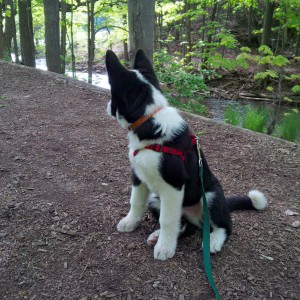
Matti is my first puppy. I did a lot of Googling to find out how to train him to be a great adult dog, and the general consensus of what I read was that positive, clicker training is the way to go. It certainly sounded better than the dominance-based training that’s been going around – personally that line of training makes me queasy, because I think it encourages bad behaviour in me. Not to mention it’s hard on the dog!
Lucky for me, my local dog boutique, BauHound Haus, is the host of a fantastic positive training group, Mindful Behaviors. So, off we went to clicker training class.
Let’s talk about the basics: bribery vs. incentive
One of the very first hurdles to get over mentally was the misconception that I was bribing my puppy to do what I wanted. I mean, here I am waiving all of these high-value treats around! How is this not bribery?
The basis of clicker training is this: if the dog does what the person asks, really good stuff happens for the dog. This positive relationship gives the dog incentive to do what you ask, because GOOD STUFF HAPPENS.
Let’s use the example of trimming a dog’s nails:
Incentive: if I let the human handle my paws and waive that funny tool around, hey, treats!
Bribe: Look at all of this FOOD! Ok, I guess I’ll let you touch my paws while I eat this stuff.
The end result here seems the same: the dog got his nails trimmed, after all.
Where bribery can backfire, though, is that you put down your trusty pile of your dog’s favourite treat and the dog backs away! No way, human! Every time you do that, stuff I don’t like happens. No deal.
Incentive says that there’s no treat unless the dog cooperates. Good behaviour earns a good reward.

Clicker training got us over puppy fear
The first couple of weeks with Matti was rough. He was scared of everything – and I do mean EVERYTHING – and would panic when confronted with new things. We couldn’t go for a simple walk around the block, because he was terrified of traffic, other dogs, and groups of people.
Clicker training helped focus Matti and get us walking down the road. How? I acted like a vending machine.
We went to the end of the driveway and waited for a car. As soon as I could hear one coming, I encouraged Matti to look in the direction, then clicked and gave him a treat. We repeated that as quickly as I could go, while the car approached and then vanished into the distance. I rewarded him for being calm, and the clicker acted as a method of saying, “what you’re doing RIGHT NOW is what I want. Good job, kid! Have a cookie!”
He knows that when the clicker makes the noise, what he’s doing is right. And that right behaviour equals a snack.
Within a day, we walked down the road. He’d worked out that a leash and a walk was awesome, because random treats fell from the sky when he walked with me. Go team!
But I don’t want to carry dog treats and a clicker forever!
A big pouch of treats and a clicker might be cramping your style. That’s fine – this is for now, not forever.
Once you have a positive association with the behaviour, for example, Matti going for a calm walk on a busy road, you lighten up on the click-treat cycle.
We started with a continuous stream of click-and-treat, then moved to every few steps. Then every 10 steps. Then a city block at a time.
Eventually, he doesn’t need the click-and-treat cycle at all. He just likes walking with us and my verbal cues of “good dog!” and the occasional ear skitch are enough to keep him going. At random, the “good dog!” includes a treat, to keep Matti extra focused – but that just means a few treats in my pocket before we head out the door. Mission accomplished!
However, let’s say that my puppy has a Big Red Button problem, like a fear of larger dogs. He might grow out of this, aided by clicking and treating calm behaviour around a bigger dog. Or he might not. But if it’s diced hotdog falling from the sky that convinces him to remain calm and focused on me instead of freaking out about another dog, I’ll carry hotdogs for the rest of my life! It’s certainly better than the alternative – escalating dog fear and aggression – don’t you agree?
Old dog, new tricks. Isn’t Fido too old to start clicker training?
Clicker training can happen at any age: it’s not too late. My 10+ year old dog certainly caught on to what the clicker meant even faster than the puppy did when we practiced on the lawn, and I’m confident she’d never seen a clicker before in her life.
Once you build that relationship between the YES! of the clicker and really good things (treats!) happening, clicker training is the shortest way to tell a dog what they’re doing is right.
Now, Misha is already pretty well behaved and trained, but I’m certain that there are things I can teach her to do, or behaviours she’s sliding on that I can reinforce in a positive way. Maybe that pesky habit she has of coming inside and creeping off of the door mat before I tell her she can go …
You can’t reward bad behavior, so how does clicker training help with misbehavour?
Simple: ask the dog to do something right, then reward that!
The classic example in our house is cat chasing. Poor kitty walks by minding her own business, and the next thing you know she’s pinned to the floor being covered in dog slobber.
In this situation, I work on two concepts with Matti:
- Leave it
- Come here
Since great stuff happens when he ignores the cat and comes over to me – attention, lots of positive attention! – he does this willingly, allowing the cat to escape.
I do this at random with toys, or other things he should not be bothering, so that my smartypants puppy doesn’t decide that the way to get praise is to bug the cat.
At first we did this exercise with the clicker and treats to be sure that the process was reinforced. Now it’s enough to just call him in a happy voice to get him to leave the cat (book, cellphone, shoe, toilet paper … ) and come get a belly rub.
How do I start clicker training my dog?
You can DIY this with some careful reading, but I found huge value in attending a clicker training class, because our trainers helped us get clear on the how and why of training specific behaviours quickly. The weekly tune-up helped train me – and the dog – about how to keep going. The classes were worth every penny, and I think we’ll do more in the future.
Blatant testimonial: if you’re in Toronto or Halton, I totally recommend Mindful Behaviours for clicker training.


